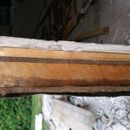Adding polyisocyanurate insulation with a laminated air barrier
Good afternoon,
I’m currently executing a complete home renovation of a bungalow located in Montreal, Quebec and would like to increase the insulation of the above grade walls.
The existing envelope of the house is composed of:
– 3.75’’ brick;
– 1.5’’ air;
– Asphalt paper air barrier;
– 0.5’’ Tentess;
– 2’’ solid wood structure;
– 0.5’’ tentess;
– kraft paper;
– 0.5’’ wood furring;
– 0.25 gypse, and;
– 0.5’’ plaster.
The proposed new envelope will be composed of :
– 3.75’’ brick;
– 1’’ air;
– 1’’ polyisocyanurate insulation board with laminated air barrier (IKO Ener-Air) with water vapour permeance of ≥60ng/Pa*s*m2;
– 2’’ existing solid wood structure;
– 2×3 new wood stud wall @ 16’’c/c, installed at 0.5’’ from existing solid wood structure to reduce thermal bridging;
– 3’’ of closed cell polyurethane insulation;
– 0.5’’ wood furring, and;
– 0.5’’ gypse.
Although the wall composition will give me the required thermal resistance of roughly R38, I am concerned with water vapor condensing on the exterior surface of the solid wood structure. Can this occur? Will the solid wood structure be able to dry with the polyisocyanurate insulation covering it?
Any comments with the pros and cons of the proposed new envelope are greatly appreciated.
GBA Detail Library
A collection of one thousand construction details organized by climate and house part










Replies
Alessio,
You reference to "Tentess" had me stumped -- never heard of it. I found a French language website with a reference to "Tentess noir," and the answer had a different spelling -- Tentest -- which led me to the solution. Tentest seems to be a type of asphalt-impregnated fiberboard made in Canada.
You are proposing a wall assembly with two types of insulation -- foil-faced polyiso and closed-cell spray polyurethane foam. As long as the sheathing and framing lumber is dry on the day that you install the insulation, your proposed assembly will probably work. I don't think that any water vapor will enter your assembly by diffusion.
That said, it is often a good idea to have a wall assembly that can dry in at least one direction. The most robust and useful layer in your wall assembly is the continuous layer of polyisocyanurate, so I would definitely include that layer. You could even make it thicker.
I would probably use a different insulation between the studs (instead of the spray foam you want to use). Either cellulose insulation or mineral wool insulation would allow the assembly to dry to the interior.
Hi Martin,
Indeed Tentest is an asphalt-impregnated fiberboard; I should have specified that in my question. My constraint with the foil faced polyiso is its thickness. I cannot put a layer thicker than 1’’.
My worry is that condensation may occur on the solid wood structure, behind the foil faced polyiso insulation board. Since there is no air circulation between these two materials, it may begin to wrought the solid wood structure. As for the interior insulation, spray foam is the only option with a high thermal resistance per inch of material. Am I worrying for nothing?
Thanks for your feedback.
Alessio,
You are in Climate Zone 6. (Here is a link to a climate zone map that includes Canada.)
If we assume that your new 2x3 wall plus 2 inches of solid wood will behave (more or less) like a 2x4 wall, then the minimum R-value for rigid foam installed on the exterior side of this wall in your climate zone is R-7.5. Your 1 inch of foil-faced polyiso will perform at about R-5 (assuming that its performance is degraded at cold temperatures), so that's not quite enough rigid foam to keep you out of trouble.
For more information on the minimum thickness of exterior rigid foam, see Calculating the Minimum Thickness of Rigid Foam Sheathing.
For more information on the performance of polyiso at cold temperatures, see Cold-Weather Performance of Polyisocyanurate.
Under the circumstances, I think that your decision to use closed-cell spray polyurethane foam between the studs makes sense. Just make absolutely sure that the wood surfaces are completely dry before the spray foam is installed.
This wall won't be able to dry out very quickly in either direction, so it's not ideal. But at least the closed-cell spray foam will stop vapor diffusion (and air movement) from the interior toward the exterior during the winter.